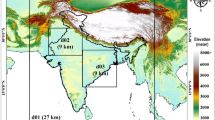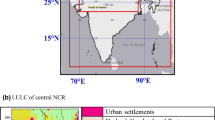Abstract
In this work, the impact of land surface physics in simulating the sea and land breeze circulation along the south east coast of India near Kalpakkam is studied using the Weather Research and Forecasting (WRF) model for emergency response application. Simulations were conducted with three different land surface models (LSMs)—5-Layer soil thermal diffusion scheme (5-Layer), Noah land surface model (Noah) and Noah Multi-Physics land surface model (Noah-MP) for different days in summer and southwest monsoon. Observations from meteorological towers, automated weather stations, sonic anemometers and GPS Radiosonde profiles were used for comparison. Results indicate that the Noah-MP followed by Noah schemes produce more realistic simulations of the sea breeze circulation in terms of intensity, onset time, duration, horizontal and vertical extents in most of the studied cases compared to the 5-Layer scheme. Results indicate that the 5-Layer model grossly overestimated air temperature, heat flux and boundary layer height relative to Noah and Noah-MP schemes. The Noah-MP scheme better represented the land-surface feedback in terms of soil temperature, skin temperature and surface energy fluxes leading to more realistic simulations of sea breeze and boundary layer characteristics.













Similar content being viewed by others
References
Attada R, Kumar P, Dasari HP (2018) Assessment of land surface models in a high-resolution atmospheric model during Indian summer monsoon. Pure Appl Geophys 175(10):3671–3696
Bhattacharya A, Mandal M (2015) Evaluation of Noah land-surface models in predicting soil temperature and moisture at two tropical sites in India. Meteorol Appl 22(3):505–512
Chen F, Dudhia J (2001) Coupling an advanced land surface–hydrology model with the Penn State–NCAR MM5 modeling system. Part I: model implementation and sensitivity. Mon Weather Rev 129(4):569–585
Dee DP, Uppala SM, Simmons AJ et al (2011) The ERA-Interim reanalysis: configuration and performance of the data assimilation system. Q J R Meteorol Soc 137:553–597
Doran JC, Fast JD, Barnard JC, Laskin A, Desyaterik Y, Gilles MK (2008) Applications of lagrangian dispersion modeling to the analysis of changes in the specific absorption of elemental carbon. Atmos Chem Phys 8(5):1377–1389
Dudhia J (1996) A multi-layer soil temperature model for MM5. Preprints. The Sixth PSU/NCAR mesoscale model users' workshop, National Centre for Atmospheric Research, Boulder, Colorado, pp 22–24
Federico S, Pasqualoni L, De Leo L, Bellecci C (2010) A study of the breeze circulation during summer and fall 2008 in Calabria, Italy. Atmos Res 97(1–2):1–13
Hari Prasad KBRR, Srinivas CV, Naidu CV, Baskaran R, Venkatraman B (2016) Assessment of surface layer parameterizations in ARW using micro-meteorological observations from a tropical station. Appl Meteorol. https://doi.org/10.1002/met.1545
Hariprasad KBRR, Srinivas CV, Bagavath Singh A, Vijaya Bhaskara Rao S, Baskaran R, Venkatraman B (2014) Numerical simulation and intercomparison of boundary layer structure with different PBL schemes in WRF using experimental observations at a tropical site. Atmos Res 145–146:27–44
Iacono MJ, Delamere JS, Mlawer EJ, Shephard MW, Clough SA, Collins WD (2008) Radiative forcing bylong-lived greenhouse gases: calculations with the AER radiative transfer models. J Geophys Res 113:D13103. https://doi.org/10.1029/2008JD009944
Igri PM, Tanessong RS, Vondou DA, Mkankam FK, Panda J (2015) Added-value of 3DVAR data assimilation in the simulation of heavy rainfall events over West and Central Africa. Pure Appl Geophys 172(10):2751–2776
Jamima P, Lakshminarasimhan J (2004) Numerical simulation of sea breeze characteristics observed at tropical coastal site, Kalpakkam. J Earth Syst Sci 113(2):197–209
Jin J, Miller NL, Schlegel N (2010) Sensitivity study of four land surface schemes in the WRF model. Adv Meteorol. https://doi.org/10.1155/2010/167436
Jonassen MO, Olafsson H, Agustsson H, Rognvaldsson O, Reuder J (2012) Improving high-resolution numerical weather simulations by assimilating data from an unmanned aerial system. Mon Weather Rev 140(11):3734–3756
Kar SC, Mali P, Routray A (2014) Impact of land surface processes on the South Asian monsoon simulations using WRF modeling system. Pure Appl Geophys 171:2461–2484
Lin YL, Farley RD, Orville HD (1983) Bulk parameterization of the snow field in a cloud model. J Clim Appl Meteorol 22(6):1065–1092
Liu H, Chan JC, Cheng AY (2001) Internal boundary layer structure under sea-breeze conditions in Hong Kong. Atmos Environ 35(4):683–692
Liu C, Dudhia J, Moncrieff MW (2010) Comparison of two land surface schemes in week-long cloud-system-resolving simulations of warm season precipitation. Meteorol Atmos Phys 107(1–2):9–15
Madala S, Satyanarayana ANV, Srinivas CV, Kumar M (2015) Mesoscale atmospheric flow-field simulations for air quality modelling over complex terrain region of Ranchi in eastern India using WRF. Atmos Environ 107:315–328
Miller STK, Keim BD, Talbot RW, Mao H (2003) Sea breeze: Structure, forecasting, and impacts. Rev Geophys 41(3)
Mishra V, Shah R, Azhar S, Shah H, Modi P, Kumar R (2018) Reconstruction of droughts in India using multiple land-surface models (1951–2015). Hydrol Earth Syst Sci 22(2269–2284):2018
Nakanishi M, Niino H (2004) An improved Mellor-Yamada level-3 model with condensation physics: its design and verification. Boundary-Layer Meteorol 112(1):1–31
Neumann J, Mahrer Y (1971) A theoretical study of the land and sea breeze circulation. J Atmos Sci 28(4):532–542
Niu GY, Yang ZL, Mitchell KE, Chen F, Ek MB, Barlage M, Kumar A, Manning K, Niyogi D, Rosero E, Tewari M (2011) The community Noah land surface model with multiparameterization options (Noah‐MP): 1. Model description and evaluation with local‐scale measurements. J Geophys Res Atmos 116(D12)
Patil MN, Waghmare RT, Halder S, Dharmaraj T (2011) Performance of Noah land surface model over the tropical semi-arid conditions in western India. Atmos Res 99(1):85–96
Raja Shekhar SS, Shantanu B, Krishna Murty YVN, Venkata Srinivas C, Venkatesan, R (2012a). ONERS: Web based indigenous decision support system. NNRMS Bulletin NNRMS(B)-36. Geospatial Applications and Decision Support Systems. In book: Geospatial Applications and Decision Support Systems, Chapter: 36, Publisher: Dept of Space, Govt of India, Bangalore, pp 68–73
Raja Shekhar SS, Bhatawadekar S, Krishna M, Srinivas CV (2012b). Development of a online nuclear emergency response system (ONERS) for Kalpakkam site-the design aspects. In Proceedings of the Nineteenth National Symposium on Radiation Physics (NSRP-19), Dec. 12–14, 2012. Mamallapuram, Tamil Nadu, India
Salamanca F, Zhang Y, Barlage M, Chen F, Mahalov A, Miao S (2018) Evaluation of the WRF-Urban modeling system coupled to Noah and Noah-MP land surface models over a semiarid urban environment. J Geophys Res Atmos 123(5):2387–2408
Salvador N, Loriato AG, Santiago A, Albuquerque TT, Reis NC Jr, Santos JM, Landulfo E, Moreira G, Lopes F, Held G, Moreira DM (2016a) Study of the thermal internal boundary layer in sea breeze conditions using different parameterizations: application of the WRF model in the Greater Vitória Region. Rev Br Meteorol 31(4):593–609
Salvador N, Reis NC, Santos JM, de Almeida Albuquerque TT, Loriato AG, Delbarre H, Augustin P, Sokolov A, Moreira DM (2016b) Evaluation of weather research and forecasting model parameterizations under sea-breeze conditions in a North Sea coastal environment. J Meteorol Res 30(6):998–1018
Shrivastava R, Dash SK, Oza RB, Hegde MN (2015) Evaluation of parameterization schemes in the weather research and forecasting (WRF) model: a case study for the Kaiga nuclear power plant site. Ann Nucl Energy 75:693–702
Simpson M, Warrior H, Raman S, Aswathanarayana PA, Mohanty UC, Suresh R (2007) Sea-breeze-initiated rainfall over the east coast of India during the Indian southwest monsoon. Nat. Hazard 42(2):401–413
Simpson M, Raman S, Suresh R, Mohanty UC (2008) Urban effects of Chennai on sea breeze induced convection and precipitation. J Earth Syst Sci 117(6):897–909
Srinivas CV, Venkatesan R, Somayaji KM, Singh AB (2006) A numerical study of sea breeze circulation observed at a tropical site Kalpakkam on the east coast of India, under different synoptic flow situations. J Earth Syst Sci 115(5):557–574
Srinivas CV, Venkatesan R, Singh AB (2007) Sensitivity of mesoscale simulations of land–sea breeze to boundary layer turbulence parameterization. Atmos Environ 41(12):2534–2548
Srinivas CV, Venkatesan R, Yesubabu V, Nagaraju C, Venkatraman B (2011a) Evaluation of the operational atmospheric model used in emergency response system at Kalpakkam on the east coast of India. Atmos Environ 45(39):7423–7442
Srinivas CV, Bagavath Singh A, Venkatesan R, Baskaran R (2011b) Creation of benchmark meteorological observations for RRE on atmospheric flowfield simulation at Kalpakkam. IGC report-213. Indira Gandhi Centre for Atomic Research, Kalpakkam 603102, Tamilnadu, India
Srinivas CV, Bhaskar Rao DV, Yesubabu V, Baskaran R, Venkatraman B (2013a) Tropical cyclone predictions over the Bay of Bengal using the high-resolution advanced research weather research and forecasting model. Q J R Meteorol Soc 139:1810–1825. https://doi.org/10.1002/qj.2064
Srinivas CV, Hariprasad D, Bhaskar Rao DV, Anjaneyulu Y, Baskaran R, Venkatraman B (2013b) Simulation of the Indian summer monsoon regional climate using advanced research WRF model. Int J Climatol 33:1195–1210
Srinivas CV, Hariprasad KBRR, Naidu CV, Baskaran R, Venkatraman B (2015) Sensitivity Analysis of atmospheric dispersion simulations by FLEXPART to the WRF simulated meteorological predictions in a coastal environment. Pure Appl Geophys 173(2016):675–700
Stohl A, Forster C, Frank A, Seibert P, Wotawa G (2005) The Lagrangian particle dispersion model FLEXPART version 6.2. Atmos Chem Phys 5(9):2461–2474
Sun X, Holmes HA, Osibanjo OO, Sun Y, Ivey CE (2017) Evaluation of surface fluxes in the WRF model: case study for farmland in rolling terrain. Atmos 8(10):197
Tarek M, Brissette FP, Arsenault R (2019) Evaluation of the ERA5 reanalysis as a potential reference dataset for hydrological modeling over North-America. Hydrol Earth Syst Sci. https://doi.org/10.5194/hess-2019-316
Tewari M, Chen F, Wang W, Dudhia J, LeMone MA, Mitchell K, Ek M, Gayno G, Wegiel J, Cuenca RH (2004) Implementation and verification of the unified NOAH land surface model in the WRF model. In: Paper 14.2A, 20th conference on Weather Analysis and Forecasting /16th conference on numerical weather prediction, Vol 1115, pp 6. https://ams.confex.com/ams/pdfpapers/69061.pdf
Thompson WT, Holt T, Pullen J (2007) Investigation of a sea breeze front in an urban environment. Q J R Meteorol Soc 133:579–594
Tiwari PR, Kar SC, Mohanty UC, Dey S, Sinha P, Raju PVS, Shekhar MS (2015) The role of land surface schemes in the regional climate model (RegCM) for seasonal scale simulations over Western Himalaya. Atmósfera México abr. 2015 28(2)
Yang ZL, Niu GY, Mitchell KE, Chen F, Ek MB, Barlage M, Longuevergne L, Manning K, Niyogi D, Tewari M, Xia Y (2011) The community Noah land surface model with multiparameterization options (Noah-MP): 2. Evaluation over global river basins. J Geophys Res 116:D12110. https://doi.org/10.1029/2010JD015140
Zeng XM, Wang N, Wang Y, Zheng Y, Zhou Z, Wang G, Chen C, Liu H (2015) WRF-simulated sensitivity to land surface schemes in short and medium ranges for a high-temperature event in East China: a comparative study. J Adv Model Earth Syst 7(3):1305–1325
Zhang Y, Chen YL, Schroeder TA, Kodama K (2005) Numerical simulations of sea-breeze circulations over northwest Hawaii. Weather Forecast 20(6):827–846
Acknowledgements
The authors are thankful to Director, IGCAR for his keen interest and support of the study. The first author is grateful to HBNI and DAE for providing the research fellowship and for extending the facilities to conduct the study. Authors thank the anonymous reviewers for their technical comments and suggestions which greatly helped to improve the contents of the manuscript.
Author information
Authors and Affiliations
Corresponding author
Additional information
Responsible Editor: E.-K. Jin.
Publisher's Note
Springer Nature remains neutral with regard to jurisdictional claims in published maps and institutional affiliations.
Rights and permissions
About this article
Cite this article
Reddy, B.R., Srinivas, C.V., Shekhar, S.S.R. et al. Impact of land surface physics in WRF on the simulation of sea breeze circulation over southeast coast of India. Meteorol Atmos Phys 132, 925–943 (2020). https://doi.org/10.1007/s00703-020-00726-5
Received:
Accepted:
Published:
Issue Date:
DOI: https://doi.org/10.1007/s00703-020-00726-5




